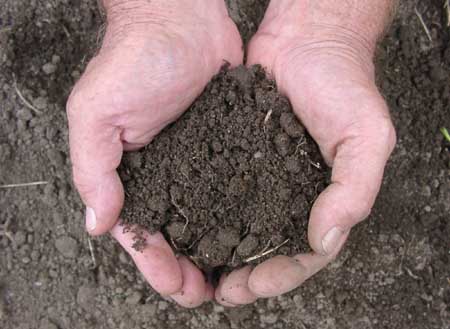Oak #1
Oak #2
Oak #3
Oak #4
Hillsides
Handful of Soil
Covercrop Growing
Mowing Covercrop
Vegetarians
Carnivores
Hover Fly Larva
Hover Fly Adults
Cilantro Flowers
Good Bug Blend
Fennel flowers
Buckwheat
Kale
Parsley
Owl House
Nesting Box
Bluebird Eggs
Baby Bluebirds
One Week
Two Weeks
Other Tactics
Let Nature Talk
|
Handful of Soil


I was amazed to find out there are hundreds of millions living organisms in this handful of soil. They all form an integrated web of life within the soil. If properly cared for, the soil life will provide all the nutrients needed for optimum plant growth.
If we had a microscope, we could see one-celled bacteria devouring dead leaves and roots.
We would see other bacteria attaching themselves to roots, taking nitrogen from the air and then supplying the host plant with nitrogen; and, in return, we would see the host plant giving the bacteria simple carbon compounds.
To our amazement, we would see stands of fungal hyphae pushing their way though the soil and binding soil particles together, creating soil aggregates.
We would see protozoa dining on bacteria & fungi and, in the process, releasing nitrogen.
If we were lucky we might see a fungus shaping itself into a noose, baiting this trap, getting ready to snag a nematode.
We would also see nematodes puncturing the cell walls of fungi and sucking out the internal contents. Or gulping down whole protozoa. Plant-invading nematodes have gotten a lot of attention, but they are only a small fraction of total nematodes. The vast majority of nematodes are beneficial to plants and play a critical role in the soil foodweb. They dine on bacteria, fungi, protozoa, and other nematodes. And in the process of eating and excreting, they release many nutrients that are readily available to plants.
We would also see earthworms, springtails and a myriad of arthropods, feasting on plant residues and microorganisms and leaving behind supercharged trails of soil.
Surrounding the roots is the narrow band called the rhizosphere. Here, the soil life is very abundant and extremely active. Roots slough-off plant cells and release proteins, sugars and other substances. These roots exudates attract bacteria which release nutrients for the plant. Evidence exists that roots release certain types of exudates to attract certain types of bacteria which release the exact nutrients the plant needs. In other words, the plant controls the release of nutrients by the type and quantity of exudates. When we concentrate on feeding the plant instead of the soil, we can interrupt these vital functions causing imbalances, disease and insect attacks.
I allow the fine-tuned natural processes of the soil do their job.
How does Nojoqui properly take care of these living organisms in the soil?
|
|
